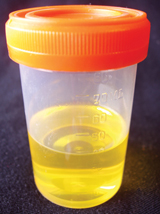Module 8 Intro
1. Module 8 Intro
1.45. Page 2
Module 8—Circulation, Immunity, and Excretion
 Explore
Explore
 Read
Read
Before you begin this lesson, you may want to read pages 311 to 315 of the textbook. The diagrams on these pages are useful in helping you to visualize the process of urine formation.
Urine Formation

© Tootles/shutterstock
Everyone depends on the process of urination for the removal of certain waste products in the body. The production of urine is vital to the body’s health. You have probably never thought of urine as valuable, but you could not survive if you did not produce it and eliminate it.
Urine is composed of water, certain electrolytes, and various waste products filtered out of the blood system. Remember, as blood flows through the body, wastes resulting from the metabolism of foodstuffs in the body cells are deposited into the bloodstream. This waste must be disposed of in some way.
Also, blood cells have a life of only about four months and, as they die, the cells are broken down. The yellow colour of urine comes from the breakdown of blood cells that is considered a waste to remove from the body.
A major part of this "cleaning" of the blood takes place in the kidneys and, in particular, in the nephrons, where the blood is filtered to produce the urine. Both kidneys in the body carry out this essential blood cleansing function. Normally, about one-fifth of the total blood pumped by the heart each minute will enter the kidneys to undergo filtration. The rest of the blood (about 80%) does not go through the filtering portion of the kidney. This blood flows through the rest of the body to serve the various nutritional, respiratory, and other needs that are always present.
There is more to the production of urine than the kidneys simply picking waste products out of the bloodstream and sending them along for final disposal. The kidneys two million or more nephrons (about a million in each kidney) form urine by three precisely regulated processes: filtration, reabsorption, and secretion.
Review the diagram of a simplified nephron to visualize the steps involved in filtration to create urine.

Inquiry into Biology (Whitby, ON: McGraw-Hill Ryerson, 2007), 311, fig. 9.4. Reproduced by permission.
You may also want to read the attached document that reviews the processes of diffusion, osmosis, and active transport.
Glomerular Filtration

© travis manley/shutterstock
Glomerular filtration moves water and solutes from blood plasma into the nephron. This filtered fluid is referred to as filtrate or what remains. The glomerular filtrate consists primarily of water, excess salts (primarily Na+ and K+), glucose, and a waste product of the body called urea. Urea is formed in the body to eliminate the very toxic ammonia products that are formed in the liver from amino acids. Since humans cannot excrete ammonia, it is converted to the less dangerous urea and then filtered out of the blood. Urea is the most abundant of the waste products that must be excreted by the kidneys.
The total rate of glomerular filtration for the whole body (i.e., for all of the nephrons in both kidneys) is normally about 125 mL per minute. That is, about 125 mL of water and dissolved substances are filtered out of the blood per minute. The following calculations may help you visualize how enormous this volume is:
125 mL/min X 60 min/hr = 7500 mL/hr or 7.5 L/hr = 180 L/day
Imagine the size of a 2-litre bottle of soda pop. About 90 of those bottles equals 180 litres! In your experience you have never excreted anywhere near 180 litres of urine per day. Why? Because almost all of the estimated 180 litres of water that leaves the blood through glomerular filtration—the first process in urine formation—returns to the blood by the second process of reabsorption.
glomerulus: a fine network of capillaries within Bowman’s capsule arising from the renal artery
Bowman’s capsule: a caplike formation at the top of each nephron that serves as a filtration structure; surrounds the glomerulus
Filtration occurs because of two factors. Firstly, the blood pressure in the glomerulus is four times greater than in other capillaries in the body. This creates a force against capillary walls that aids in moving water and solutes from the blood to Bowman’s capsule. Secondly, the glomerulus’ capillaries are quite permeable. Thus, small molecules (including water, NaCl, glucose, urea, and certain amino acids) are forced into Bowman’s capsule. Larger proteins and red blood cells are left behind in the arteriole leading away from the glomerulus. If protein or blood is found in urine, this indicates a problem.
 Inquiry into Biology (Whitby, ON: McGraw-Hill Ryerson, 2007), 311, fig. 9.4. Reproduced by permission.
Inquiry into Biology (Whitby, ON: McGraw-Hill Ryerson, 2007), 311, fig. 9.4. Reproduced by permission.
 Try This
Try This
TR 1. Glomerular Filtration
Urine formation occurs as blood pressure forces filtrate from the glomerulus into Bowman’s capsule. This bulk flow of fluids into the Bowman’s capsules of the nephrons in both kidneys creates about 180 L of filtrate per day. All but about 1 L will be actively reabsorbed back into the blood, with a great expenditure of ATP.
Go to your Lesson 8 Assignment to respond to how this process will work.